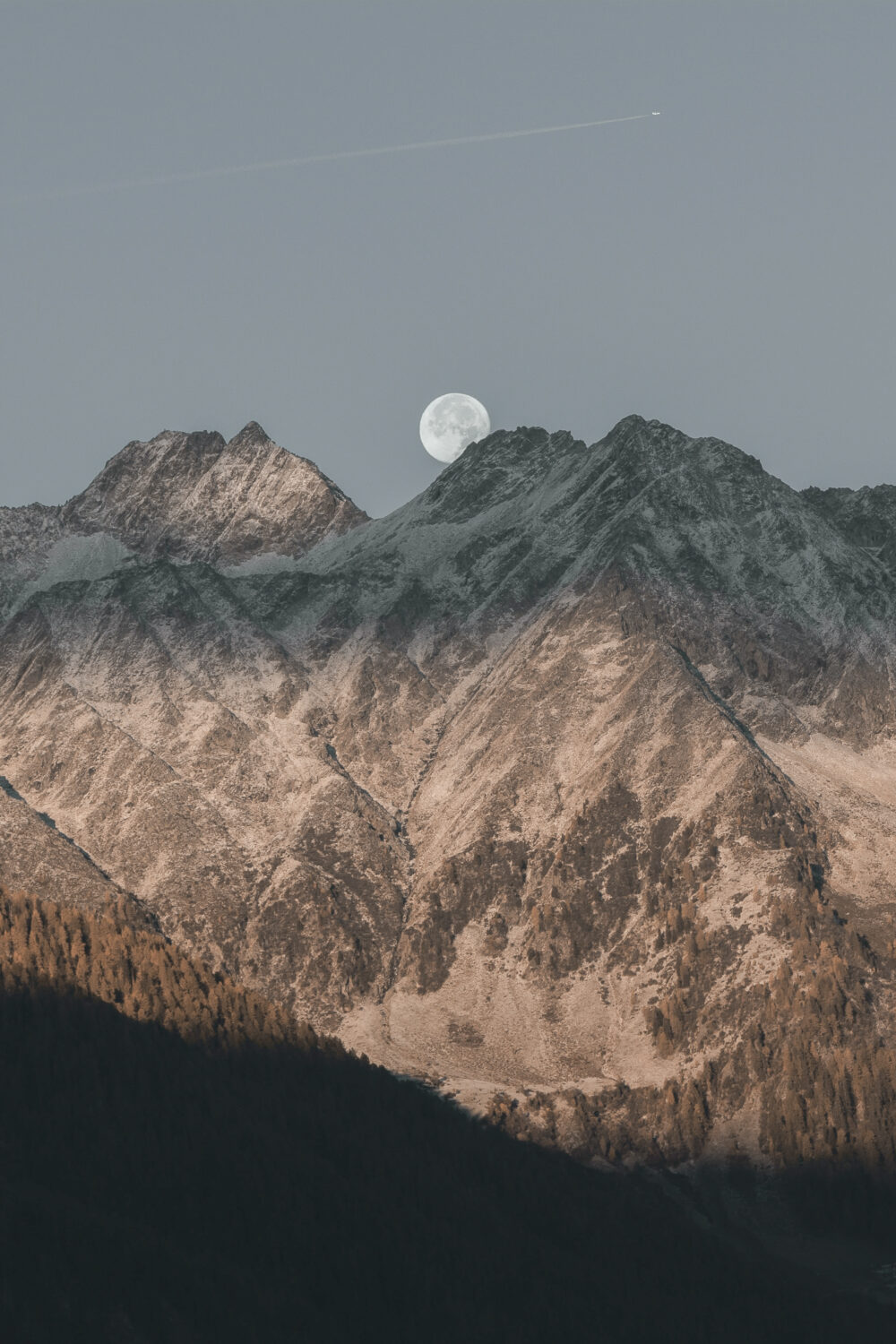How to Photograph the Moon, what settings and lenses to use? It’s a question I get all the time. The moon, our celestial companion, has inspired awe and wonder throughout human history. Its silvery glow against the night sky has captivated poets, artists, and dreamers alike.
Now, armed with modern photography techniques, we have the opportunity to capture the moon’s enchantment in stunning detail. In this article, we delve into the world of lunar photography, uncovering the art and science behind capturing this celestial wonder.
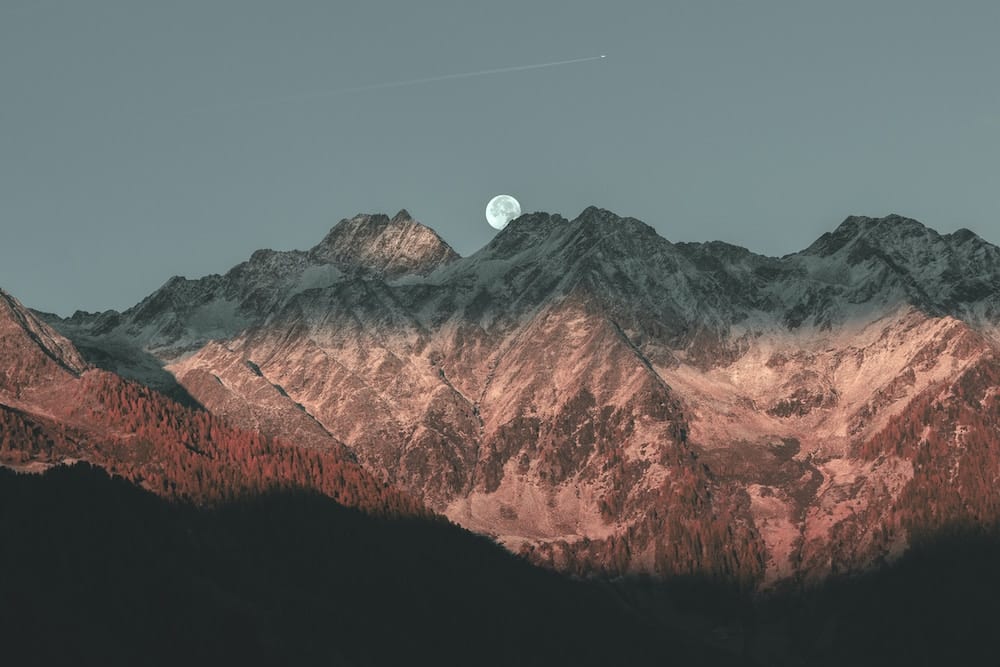
How to Photograph the Moon: Shopping for the correct lenses
When learning how to photograph the moon, using the right lenses can greatly impact the quality and detail of your shots. Moreover, telephoto and zoom lenses are particularly well-suited for capturing the moon’s intricate features
Long lenses, around 200mm to 400mm or more, are ideal for taking detailed pictures of the moon up close. These lenses enable you to capture intricate details like craters, maria, and other fine features that shorter focal lengths might overlook.
Having a telephoto or zoom lens with image stabilization can prevent camera shake caused by the Earth’s rotation during longer exposures. This results in sharper and clearer moon images. So, opt for a telephoto or zoom lens with a longer focal length for stunning and detailed moon photography.
Building the Foundation: Camera Settings and ISO
Successful moon photography starts with understanding and controlling your camera settings. Begin by setting your camera’s ISO to its lowest value, which is typically ISO 100.
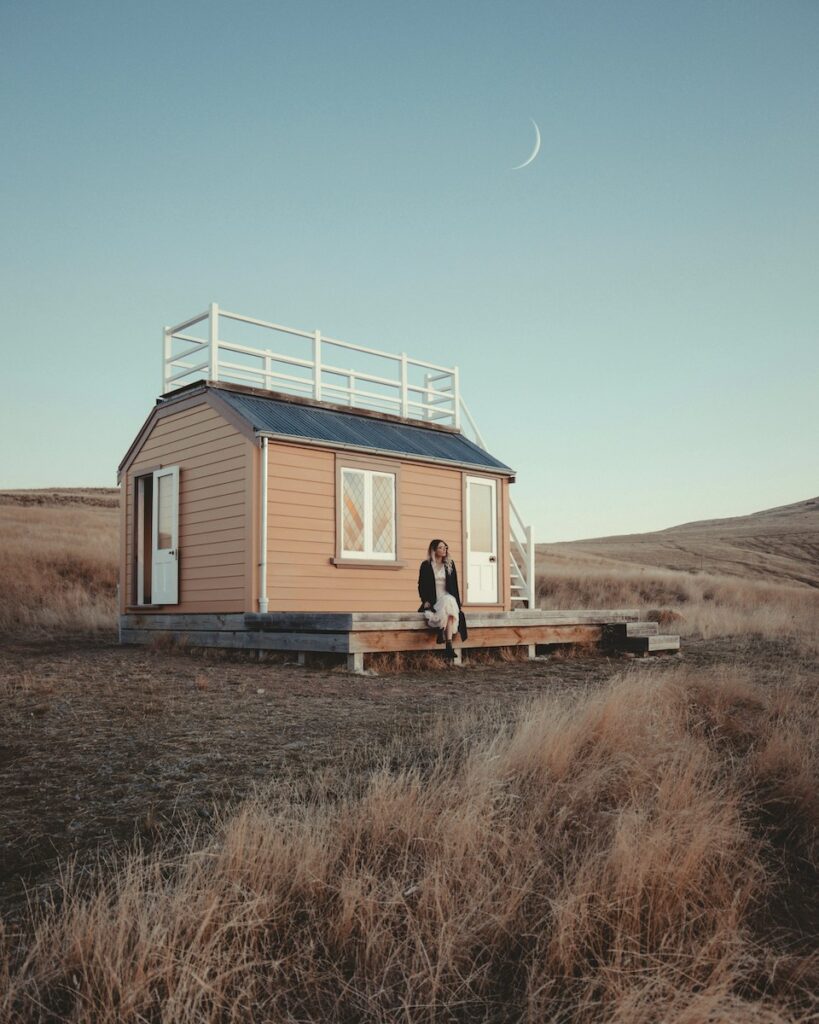
A low ISO reduces noise and enhances image quality. This enables you to capture the moon’s intricate details and textures, even in low-light conditions. Timing is Key: Full Moon and Phases of the Moon
When embarking on moon photography, consider the timing and phase of the moon. The full moon offers a breathtaking sight, where the entire surface of the moon is visible. However, each lunar phase presents its own unique charm.
Each phase provides varying angles of lighting, casting captivating shadows and enhancing surface features.
Best Apps for Moon Photography
- PhotoPills: PhotoPills is a comprehensive photography planning app. It assists in calculating optimal moonrise, moonset, and moon phase times and locations based on your specific date and location. The app offers valuable information about the moon’s sky position, aiding your moon photography planning and execution.
- The Photographer’s Ephemeris (TPE): TPE is a popular app that provides detailed information about the sun and moon’s positions. It also shows their paths across the sky. It helps you plan your moon photography by showing you where the moon will rise. That way you can set it to landmarks or natural features in your chosen location.
- SkySafari: SkySafari is an astronomy app that offers interactive star maps and celestial object tracking. While primarily utilized for astronomy, it also proves beneficial for moon photography. You can employ it to pinpoint the moon’s position in the night sky. It will also forecast its trajectory for a particular date and time.
- Dark Sky Finder: Dark Sky Finder is an app designed to aid in locating areas with minimal light pollution. This makes it simpler to capture moon shots that are both clear and detailed. By identifying dark sky locations, you can reduce the impact of light pollution on your moon photography.
- Clear Outside: Clear Outside is a weather forecasting app tailored for astronomers and photographers. It provides detailed weather information specific to your location, including cloud cover, humidity, and visibility. Monitoring weather conditions is essential for successful moon photography, ensuring you have clear skies and optimal visibility.
These apps can be valuable tools in your moon photography journey, aiding you in planning and executing your shots effectively.
Achieving Sharpness: Manual Focusing and Zoom Lens
Manual focusing is a crucial aspect of moon photography. Due to the low-light conditions, autofocus may struggle, leading to blurred images.
Use your camera’s Live View mode to magnify the moon on the screen, making precise manual focusing easier. If you have a zoom lens available, opt for a longer focal length, typically ranging from 200mm to 400mm or higher. This telephoto or zoom lens allows you to capture a close-up shot of the moon. It will also reveal intricate details such as craters and lunar maria.
Photographing Different Moon Phases: Adapting Your Technique
Photographing the moon involves adapting your technique to the moon’s phases. During a full moon, the moon is brighter, allowing for shorter exposure times. However, as the moon waxes or wanes, longer exposures may be necessary to capture the fine details on its surface.
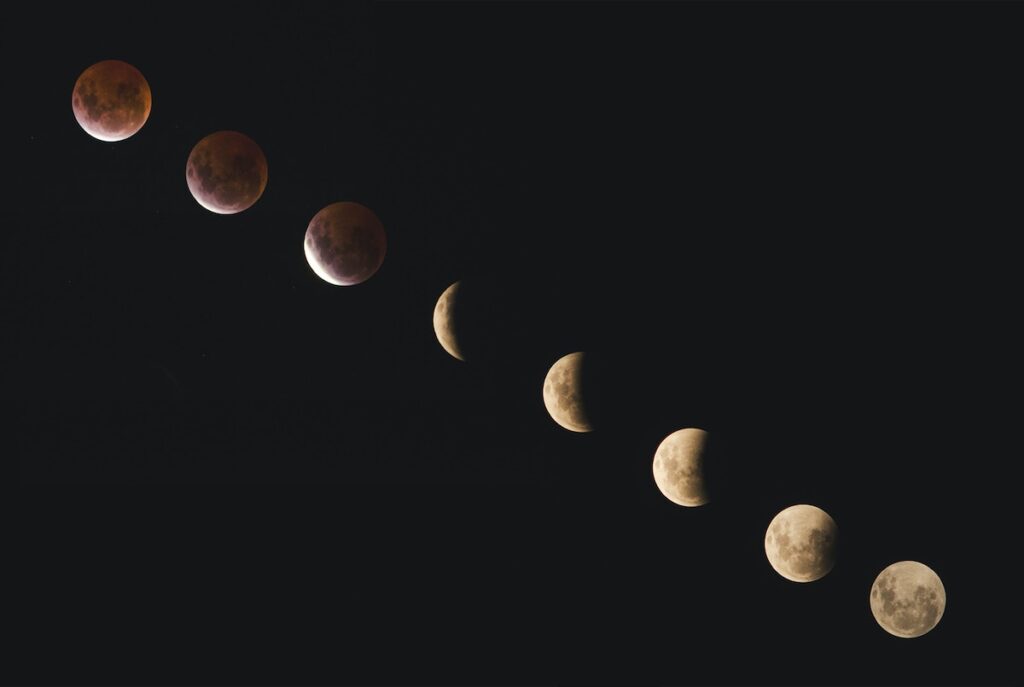
Capturing the Total Lunar Eclipse: A Unique Phenomenon
A total lunar eclipse is a rare celestial event that transforms the moon into a mesmerizing reddish orb. To capture this phenomenon effectively, be prepared to adjust your camera settings as the lighting conditions change. To avoid camera shake during these extended shots, it’s crucial to have a sturdy tripod, as longer exposures might become necessary.
Optimal ISO Settings and Longer Exposures for Night Sky Photography
When photographing the moon at night, it’s important to find the right ISO and exposure settings. Gradually increase your ISO setting if you need more light to capture the moon’s details. However, be cautious not to set it too high, as it can introduce unwanted noise into your images.
For longer exposures, a tripod is a necessary tool to ensure your images are sharp and free from camera shake. It’s good to understand how to photograph the moon from a technical angle.
Photograph the Moon: 5 Tips
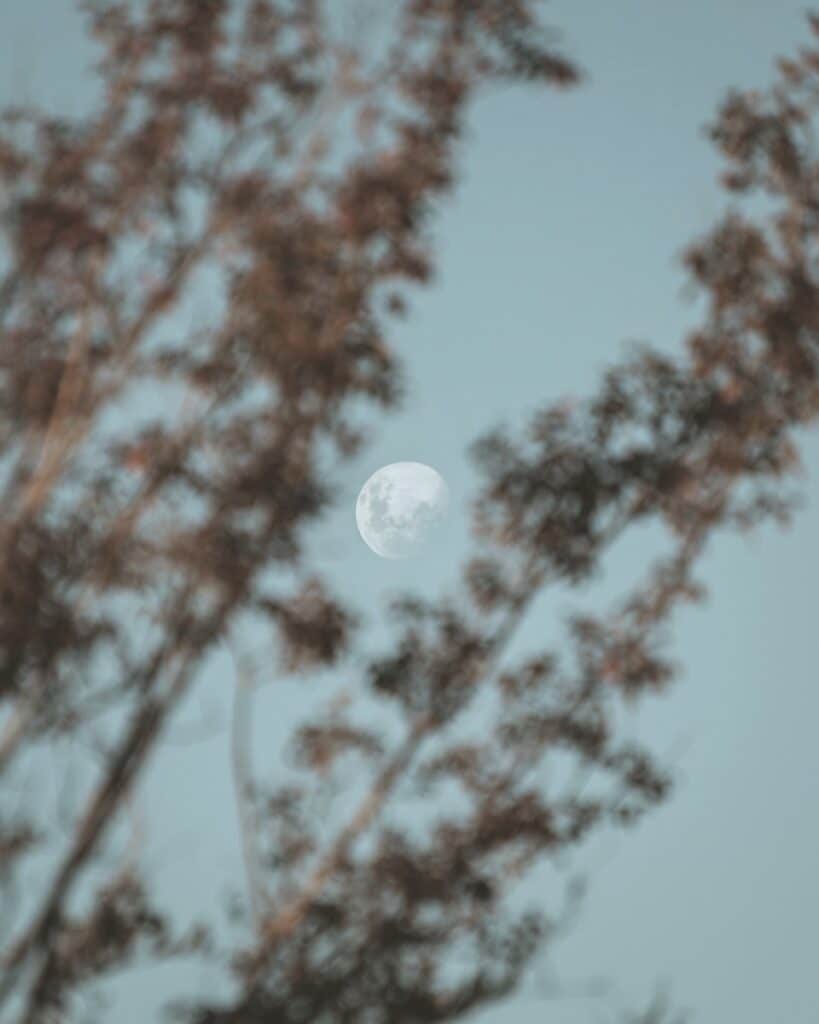
- Stable Tripod: Utilize a sturdy tripod to eliminate camera shake and capture sharp moon images. I swear by my Peak Design Tripod.
- Remote Shutter Release: Employ a remote shutter release or the camera’s timer to minimize vibrations caused by pressing the shutter button.
- Experiment with Exposure: Don’t hesitate to experiment with exposure settings to achieve the desired brightness and level of detail.
- Patience and Persistence: Moon photography demands practice. Refine your techniques and settings for optimal results.
- Post-Processing Enhancement: After capturing your moon photos, consider post-processing techniques to enhance sharpness, contrast, and color balance.
Step-by-step cheat sheet for Photographing the Moon
Select the Right Gear:
- Use a DSLR or mirrorless camera with manual settings.
- Opt for a telephoto or zoom lens with a focal length of 200mm to 400mm or higher.
- Use a sturdy tripod to prevent camera shake during longer exposures.
Choose the Right Location:
- Find a location with minimal light pollution for clearer skies.
- Plan the composition with interesting foreground elements if desired.
Camera Settings:
- Set your camera to Manual (M) mode.
- Set ISO to its lowest value, typically ISO 100, to reduce noise.
- Choose a narrow aperture (high f-number) for better sharpness, like f/8 to f/11.
- Start with a faster shutter speed to avoid overexposure, like 1/125 or 1/250 seconds.
Manual Focusing:
- Switch your lens to manual focus mode.
- Use Live View to magnify the moon on the LCD screen.
- Adjust the focus until the moon’s edges appear sharp.
Frame and Compose:
- Position the moon in your desired composition.
- Consider including interesting elements like trees or buildings for context.
Capture the Moon:
- Set the camera to continuous shooting mode if possible.
- Use a remote shutter release or the camera’s built-in timer to avoid camera shake.
- Take test shots and adjust settings if needed.
Review and Adjust:
- Review your shots on the camera’s LCD screen.
- Zoom in to check for sharpness and detail.
- Make adjustments to exposure settings if necessary.
Longer Exposures for Details:
- If the moon appears overexposed, gradually decrease the shutter speed.
- Longer exposures help reveal lunar features, so experiment with longer times.
Post-Processing:
- Transfer your photos to a computer for post-processing.
- Use software like Adobe Lightroom or Photoshop to enhance sharpness, contrast, and color balance.
- Avoid excessive editing to maintain a natural look.
10 Best Places in the world to Photograph the Moon
As a lover of night sky photography, the beautiful Namib Desert in Namibia during my trip left me breathless.
Here, amidst the vast expanse of the desert, I found myself entranced by the moon’s luminous glow against the towering dunes.
The remote location and the clear, unpolluted skies provided the perfect canvas for my art. With every camera click, I preserved the moon’s delicate details and textures. This created a picture of the moon blending with the desert’s ethereal landscape.
Top 5 Best Places to Photograph the Moon
- Mauna Kea, Hawaii, USA: Night sky photographers hold this location in high regard. The summit provides minimal light pollution, establishing an optimal environment for capturing both the moon and distant stars.
- Namib Desert, Namibia: The vast desert landscape and remote location make the Namib Desert an excellent spot for star photography. The combination of the moonlit dunes and the Milky Way creates an otherworldly scene.
- Atacama Desert, Chile: Renowned as one of the driest places on Earth, the Atacama Desert is famous for its clarity. Its skies are incredibly clear, with minimal atmospheric interference. This makes it an outstanding location for capturing both the moon and the stunning night sky.
- Uluru (Ayers Rock), Australia: The iconic Uluru provides a unique backdrop for moon and night sky photography. The clear Australian Outback skies showcase the moon’s radiance, and the desert setting adds an extra dimension to your shots.
- Lofoten Islands, Norway: In the Arctic Circle, the Lofoten Islands offer opportunities to capture the moon and the northern lights together. The dramatic landscapes, fjords, and snow-covered peaks add to the allure of this location.
Other Incredible Places
- Torres del Paine National Park, Chile: This remote national park offers stunning landscapes and clear skies. Capturing the moonrise or moonset over the iconic Cuernos del Paine mountains can result in spectacular images.
- Svalbard, Norway: Located in the high Arctic, Svalbard provides extended periods of darkness. This setting offers a unique opportunity to capture the moon against the distinct Arctic landscape. It’s also a prime spot for witnessing the polar night.
- Teide National Park, Tenerife, Spain: Teide volcano in Tenerife is great for capturing photos of the moon and stars. It offers a surreal volcanic landscape as a backdrop, enhancing the celestial experience. The high altitude and low light pollution create optimal conditions for night sky photography.
- Joshua Tree National Park, California, USA: Joshua trees and rocks make a cool background for the moon and night sky. The park’s designation as an International Dark Sky Park ensures minimal light pollution.
- Aoraki Mackenzie Dark Sky Reserve, New Zealand: This designated dark sky reserve is a perfect location for capturing the moon. The pristine night skies and stunning landscapes make it a photographer’s paradise.
Is it worth staying up to Photograph the Moon?
In conclusion, moon photography offers an extraordinary opportunity to capture the celestial beauty that graces our night sky. Once you know how to photograph the moon, you will love it.
Photographers can capture the moon’s enchantment in various phases by comprehending camera settings. Using the right tools and learning manual focusing helps us better enjoy the moon’s beauty at night.
If you want to take pictures of the moon, it’s important to practice and improve your skills. This will allow you to capture its beauty and share it with others.
Frequently Asked Questions regarding Moon Photography
For the supermoon use a longer focal length to capture the moon when it’s closer to the horizon for a dramatic effect. Bracket exposures to capture the subtle changes in the moon’s appearance during different phases of the lunar eclipse.
Yes, you can certainly photograph the Moon with your iPhone, but keep in mind that the results may vary compared to using a dedicated camera with manual settings. Just like with a DSLR, use a tripod or any stable surface to avoid camera shake. This is especially important when photographing objects at a distance, like the Moon.
I love using a telescope for astrophotography. For prime focus photography, you may want to remove the telescope’s eyepiece and use your camera’s sensor as the focal point. Many telescopes have adapters for attaching cameras. Use a T-ring and T-adapter compatible with your camera model to connect it.
Are you interested in Photography and Content Creation?
For more adventurous travels, make sure you check out Discover Warredal: A Unique Treehouse Resort Experience in Belgium and Epic Hike to Olpererhütte in the Zillertal Alps, Austria. If you like content creation and want to dig into expanding your camera gear, make sure you check out:
10 Best Apps to Make Collages for Instagram Stories
Best Typography Apps for Instagram Stories
These are the 10 Best Camera Bags for Travel in 2024
